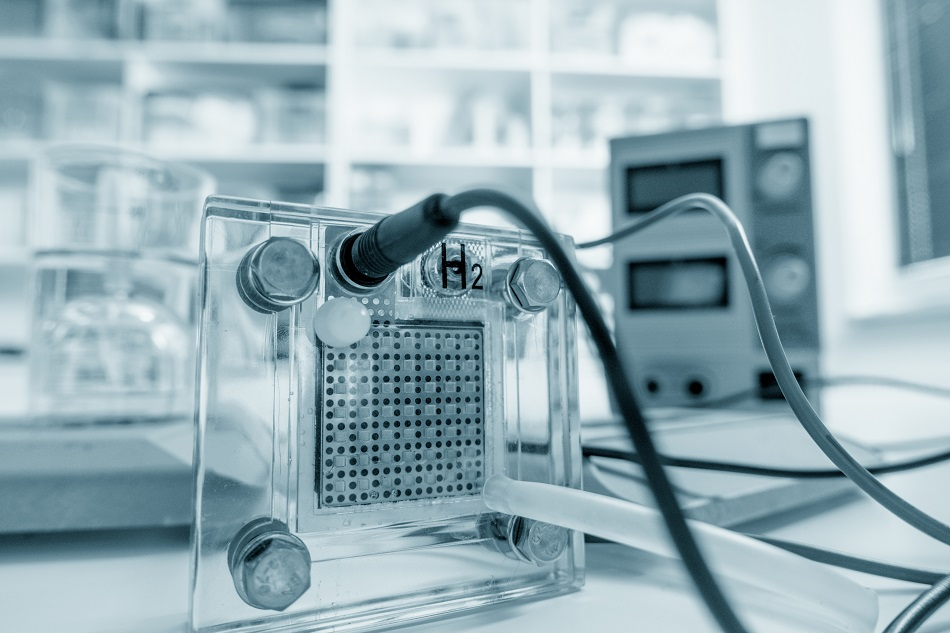
Image Credit: science photo/Shutterstock.com
A fuel cell is a device that combines chemical energy from fuel with an oxidizing agent to produce electricity. As long as fuel and oxygen are supplied to the fuel cell, energy production is continuous.
Fuel cells are mainly categorized by the type of electrolyte they use. This governs the type of catalysts needed and the type of chemical reactions that occur inside the fuel cell. The type of electrolyte used also determines factors such as the type of fuel required and the temperature range that the cell operates in. Importantly, these properties ultimately decide the applications that these fuel cells are most suitable.
Polymer Electrolyte Membrane Fuel Cells
Polymer electrolyte membrane fuel cells provide high-power density and the advantages of low weight and volume compared to other types of fuel cells. Also referred to as proton exchange membrane fuel cells, polymer electrolyte membrane fuel cells employ porous carbon electrodes containing a platinum catalyst and a solid polymer as the electrolyte.
For the polymer electrolyte membrane fuel cells to operate, hydrogen, water, and oxygen from air are required. Polymer electrolyte membrane fuel cells are typically fueled with pure hydrogen supplied from onboard reformers or storage tanks.
.jpg)
Figure 1. Polymer electrolyte membrane fuel cell. Image Credit: US Dept. of Energy
Polymer electrolyte membrane fuel cells are mainly used for transportation applications such as cars and buses and they operate at relatively low temperatures.
Direct Methanol Fuel Cells
Direct methanol fuel cells are powered by pure methanol. Methanol has a lower energy density than gasoline or diesel fuel but has a higher energy density than hydrogen. Since it is a liquid similar to gasoline, methanol is also easier to transport and supply to the public using existing infrastructure.
The methanol used in a direct methanol fuel cell is mixed with steam which is then fed directly to the fuel cell anode. Direct methanol fuel cell technology is relatively new compared to hydrogen fuel cells.
Alkaline Fuel Cells
Alkaline fuel cells can employ several non-precious metals as a catalyst at the cathode and anode and a solution of potassium hydroxide in water as the electrolyte.
.jpg)
Figure 2. Alkaline fuel cell. Image Credit: US Dept. of Energy
The high performance of alkaline fuel cells is due to the rate that chemical reactions occur in the cell. However, alkaline fuel cells are easily poisoned by carbon dioxide; a small amount of carbon dioxide in the air can negatively affect the entire operation of the fuel cell.
Phosphoric Acid Fuel Cells
Phosphoric acid fuel cells employ porous carbon electrodes containing a platinum catalyst and liquid phosphoric acid, which is stored in a Teflon-bonded silicon carbide matrix as an electrolyte.
.jpg)
Figure 3. Phosphoric acid fuel cell. Image Credit: US Dept. of Energy
Phosphoric acid fuel cells are around 85 percent efficient when they are used for the generation of heat and electricity. However, phosphoric acid fuel cells are less efficient when they are used to generate only electricity. Phosphoric acid fuel cells are generally large and heavy because they are less powerful when compared to other types of fuel cells. Phosphoric acid fuel cells are also more expensive since the fuel cells require an expensive platinum catalyst.
Molten Carbonate Fuel Cells
Molten carbonate fuel cells employ a molten carbonate salt mixture electrolyte which is suspended in a porous chemically inert lithium aluminum oxide ceramic matrix. Molten carbonate fuel cells are high-temperature fuel cells that offer significant cost reductions over phosphoric acid fuel cells.
Molten carbonate fuel cells also offer a significant increase in efficiency of around 60 percent when they are used to generate electricity, compared to phosphoric acid fuel cells. The major drawback of current molten carbonate fuel cell technology is its durability.
.jpg)
Figure 4. Molten carbonate fuel cell. Image Credit: US Dept. of Energy
Solid Oxide Fuel Cells
Solid oxide fuel cells use a hard, non-porous ceramic compound as the electrolyte. An efficiency of around 50 to 60 percent can be expected when solid oxide fuel cells are used to convert fuel into electricity. Since solid oxide fuel cells operate at very high temperatures, there is no need for catalysts made from precious metals. Consequently, the cost of solid oxide fuel cells is reduced.
.jpg)
Figure 5. Solid oxide fuel cell. Image Credit: US Dept. of Energy
Regenerative Fuel Cells
Like other fuel cells, regenerative fuel cells produce electricity from oxygen and hydrogen and emit heat and water as by-products. Regenerative fuel cells can also be used with solar power or other sources of electricity to split water produced as a by-product into hydrogen and oxygen in a process referred to as electrolysis.
Regenerative fuel cells are a comparatively new type of fuel cell technology that is currently under development by organizations such as NASA.
This article was updated on 24th February, 2020.
Disclaimer: The views expressed here are those of the author expressed in their private capacity and do not necessarily represent the views of AZoM.com Limited T/A AZoNetwork the owner and operator of this website. This disclaimer forms part of the Terms and conditions of use of this website.